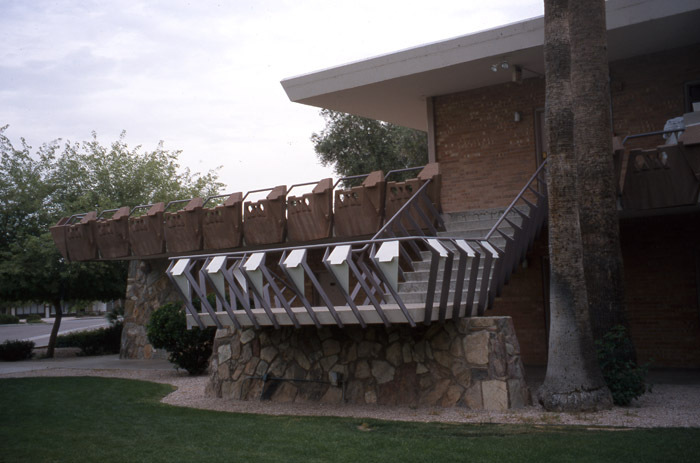
Hotel Valley Ho remains one of the only examples of of the midcentury motor hotel boom.
Built in 1956, the Hotel Valley Ho never had time for its original grand opening. The rooms filled up far too quickly to bother. The hotel thrived as tourists were drawn to Scottsdale's burgeoning arts and culture district; the industrial giant, Motorola, arranged to temporarily house its relocated employees in the hotel's graceful poolside rooms. Not only was the Valley Ho fully air conditioned, but it was open year round--an early innovator in this respect among Valley's hotels and resorts.
The hotel bridged competing trends that emerged in post-war Scottsdale between the Chamber of Commerce's "West's Most Western Town" branding and an emerging emphasis on high-end art and design.
Renowned architect Edward Varney joined these traditions through his design, melding organic southwestern architecture with the sleek, angular lines of mid-century modernism. Likewise, hotel operators, Bob and Evelyn Foehl, selected a name for the modernist design that resulted from a contest that asked the community to find a moniker that conveyed the appropriate "westward flavor." In bridging the nostalgic and the modern, the Valley Ho became an important symbol of 1950s Scottsdale's development. The postwar economic boom bred a host of luxury accommodations and tourist amenities in Scottsdale, and because travel and recreation, if only for a few weeks a year, were now within reach for many more Americans, Scottsdale quickly lured flocks of vacationers and seasonal residents. Scottsdale was forging its identity and aimed at glamor and glitz but differentiated itself by celebrating local southwestern aesthetics and traditions.
In 1973, the Ramada Inn Hotel chain, which owned an adjacent motel, acquired the hotel as part of a larger conference center. The new conference center and hotel took the name Ramada Valley Ho, although the new owners covered much of the mid-century architectural features that many viewed as outdated. The hotel continued to serve conference goers and tourists alike, but an aging infrastructure and increasingly competitive hotel market eroded its economic viability. In 2001, as Ramada Inn closed the hotel, local preservationists worried that the hotel might be bulldozed. Indeed, preservation reports noted that "with the Safari Hotel's demolition in the late 1990s, the Hotel Valley Ho is the only remaining postwar resort or hotel in the Valley, and conceivably, in Arizona, that has not had substantial changes to design, materials or architectural features. Of the major examples of motor hotels published in the architectural journals of the 1950s, none with the prototypical nature of the Hotel Valley Ho remain today."
Westroc Hotels & Resorts purchased the property--which had been placed on the Scottsdale Historic Register--in 2002, and invested more than $80 million in its rehabilitation. Reopened in 2005, the renovated hotel retained its original character. Westroc salvaged existing wings and the courtyard., as well as original brick walls, concrete railings, and fascia. It also preserved the custom steel open stairs of triangular patterns. New additions included a conference center and recreating Trader Vic's Restaurant, and additional levels were provided using the original 1956 drawings as inspiration. Allen & Phillip Architects led the renovation project.
Audio
Images




Date: 2001

